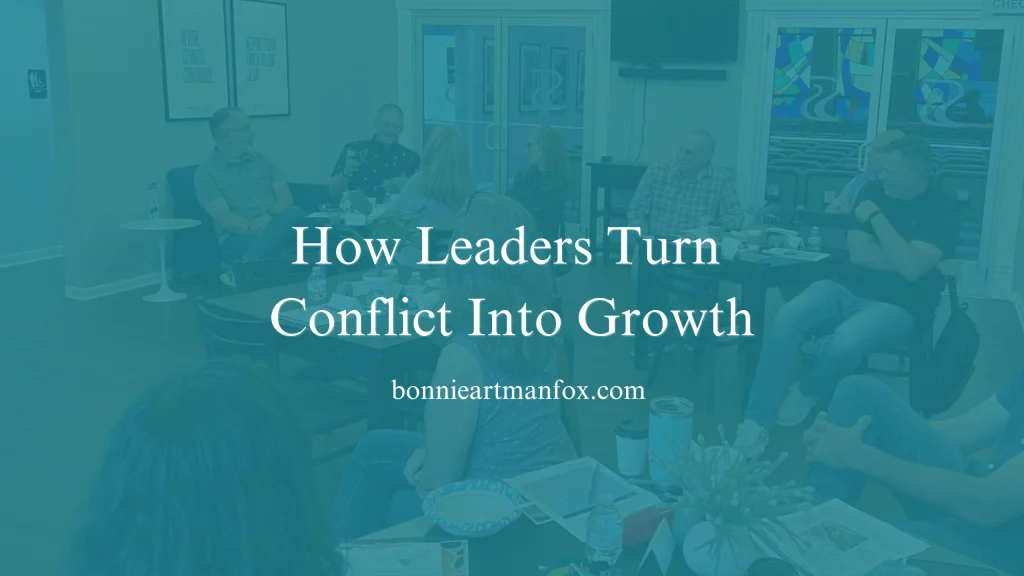
How Leaders Turn Conflict Into Growth
Leadership isn’t just about strategy, performance metrics, or vision casting. At its core, leadership is about people. And where there are people, conflict is inevitable.
Even the strongest leaders find themselves caught off guard:
- A tense meeting where emotions run high.
- A team member who deflects responsibility and projects blame.
- That sinking moment when you realize you reacted in a way that didn’t align with the leader you want to be.
If you’ve ever been there, you’re not alone. These challenges are part of the real-world side of leadership that no business school case study fully prepares you for.
Why Conflict Is So Hard for Leaders
Conflict has a way of triggering our most automatic responses.
Some leaders avoid it, hoping tension will pass if left unaddressed.
Others dive in defensively, escalating the situation without meaning to. And some internalize the stress until it quietly drains their energy and focus.
The cost? Resentment builds, gossip spreads, turnover increases, and the very culture you’re trying to build begins to erode.
The Conscious Conflict Difference
This is where Conscious Conflict changes everything.
Instead of reacting on autopilot, leaders learn to pause and make intentional choices. They recognize that while they can’t control how others show up, they can control their own presence.
During a recent training, I wish you could have been in the room. The humility was extraordinary, leaders opening up about their own conflict tendencies and asking the hard questions: “How do I manage my reactivity so difficult conversations can become breakthroughs instead of breakdowns?”
As one leader spoke vulnerably, others followed. They admitted their struggles with team members who project blame or take little ownership. But instead of pointing fingers, they turned the mirror on themselves. They recognized it was up to them to model healthier conflict behaviors—to regulate themselves, hold steady, and set the tone for accountability and trust.
One leader put it this way: “I learned how to regulate myself. I can’t control anyone else, but I can stay calm and present.”
Another reflected: “I really understand myself now, how I respond and interact with others when conflict shows up.”
That shift in awareness transforms conflict from something to avoid or fear into something that can actually strengthen relationships and build trust.
What Conscious Conflict Looks Like in Action
Imagine you’re in a meeting and an employee suddenly pushes back harshly against your decision. Instead of matching their energy, or shutting the conversation down, you take a breath, steady yourself, and respond with curiosity:
“I hear the frustration in what you’re saying. Let’s slow down so I can understand what’s at the heart of your concern.”
Or picture a scenario where two team members are locked in disagreement. Instead of choosing sides, you create space for both to be heard, modeling what it looks like to hold tension without fueling drama.
These moments, handled with calm presence, change the entire tone of your culture.
The Transformation Leaders Experience
Leaders who embrace Conscious Conflict walk away with:
- The ability to stay grounded when emotions run high.
- The confidence to hold space for difficult conversations long enough for real breakthroughs.
- Tools to break free from destructive patterns and lead from choice, not reaction.
- Emotional regulation strategies that keep compassion and authority intact.
And the ripple effect is undeniable. Leaders who handle conflict consciously build workplaces where trust deepens, accountability grows, and people feel safe enough to bring their best selves forward.
The Bigger Picture
Here’s the truth: you can’t stop conflict from happening. But you can master how you respond. And that choice is what sets great leaders apart.
Conscious Conflict isn’t about avoiding the hard stuff, it’s about equipping yourself and your team to navigate it with clarity, courage, and confidence. When leaders choose to engage conflict consciously, they don’t just solve problems. They build cultures where people thrive.
Ready to Strengthen Your Leadership?
If you’re ready to explore how Conscious Conflict could support you and your team, I’d love to talk.Schedule a call today, and let’s discuss how to equip your leadership with the tools to navigate conflict, and turn it into growth.
About the author

Bonnie Artman Fox, MS, LMFT works with executive leaders who want to gain self-awareness about the impact of their words and actions and up-level their interpersonal skills.
Drawing from decades as a psychiatric nurse and licensed family therapist, Bonnie brings a unique perspective to equip executive leaders with the roadmap to emotional intelligence that brings teams together.
Bonnie’s leadership Turnaround coaching program has an 82% success rate in guiding leaders to replace abrasive behavior with tact, empathy, and consideration of others. The end result is a happy, healthy, and profitable workplace…sooner vs. later.
